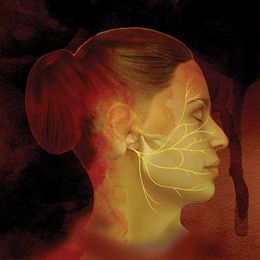Hema flew down from Srinagar to see me. She was drop-dead gorgeous: flawless skin, impeccably symmetrical eyebrows, expressive dark brown eyes, and long healthy eyelashes. Her nose looked as if it was sculpted by Michelangelo. Her cheekbones and jawline would make an anatomist gaze in wonder. She had bouncy burgundy hair reminiscent of Dimple Kapadia’s in her youth.
I thought it was perfectly appropriate for a doctor to momentarily appreciate utopian beauty within the quiet recesses of his brain. In fact, looking at her, I was reminded of the 13th-century Persian poet and Sufi mystic Amir Khusrau, who famously proclaimed Kashmir’s beauty with, “If there is a paradise on earth, it is this, it is this, it is this.”
When I asked what the problem was, and before her docile husband sitting next to her could answer, her left eye started twitching. For a moment, I thought she was winking at me, but then her face also fluttered a little uncontrollably, grimacing involuntarily, transiently disturbing the natural beauty of her face, like it was trying to communicate in Morse code to a passing firefly. “Every time she’s stressed, fatigued, or anxious, the tremble exaggerates,” her husband said.
“It’s as if I’m fighting a war inside my face,” she spoke for the first time. Kashmir had transformed from being the bliss it once was to the battlefield we now know it to be. “This started several years ago, but the intensity and frequency are now increasing,” she told me, adding how socially embarrassing this was for her. “We’ve tried everything—medication, Botox, stimulation, and even alternative forms of therapy—but it’s just getting worse,” her husband added. In case you’re wondering, Botox is often used medically to control spasms, not only to enhance beauty.
They had come to me because they knew the only option now to fix this was a surgical procedure. Hema had a condition called hemifacial spasm, where an abnormal artery was pulsating upon the seventh cranial nerve—the facial nerve responsible for the muscles of facial expression. Every time the artery touched the nerve, the face would contort. “We’ve been avoiding surgery for so long because we are very scared,” her husband spoke, adding that they had been forewarned that facial paralysis could be a complication of the operation.
“Fear is not an emotion anyone must associate with,” I gave them some hope and courage. I acknowledged it was a possibility but assured them that if at all it happened, it would be transient. “The bigger concern is that on occasion, even despite surgery, the spasms don’t disappear,” I revealed. Nonetheless, we fixed up a date for surgery.
Within a week she was in the operating room. Under the magnificent light of the microscope, her facial nerve looked more sublime than her face itself. White and yellow in equal proportion, like on the days you see the sun and moon holding hands next to each other against a pale sky.
A thick scarlet artery grooved over the nerve, hugging it like a jealous ex. I teased off the silver strands that held the artery against the nerve, and with a pair of pointed forceps, lifted it up and moved it away—the indentation on the nerve clearing up just like the dent in a cushion flattens out after someone gets up from it. I placed a buffer of fluffy Teflon between the two just in case the artery was to recoil back onto the nerve, like a jilted lover wanting to get back again.
When she woke up and smiled, her face was in perfect symmetry. The twitching had disappeared. Flowers bloomed where there once was bloodshed. No one was going to war. Paradise was restored.
The author is consultant neurosurgeon at Wockhardt Hospital, Mumbai.
mazdaturel@gmail.com, Instagram@mazdaturel


